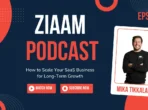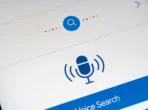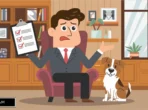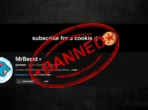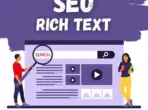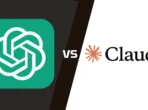Subscribe to the our newsletter to receive latest news straight to your inbox.
How to Create a Business Facebook Page without Personal Account
Top 5 Chat GPT Use Cases for Business in 2025
How to Scale Your SaaS Business for Long-Term Growth
Best 1000 SEO Keywords for Theme Park to Boost Your Visibility
10 Best Free Landing Page Templates WordPress Users Must Try
How to Create Quiz Lead Magnet – Beginners Guide
Lead vs Conversion: 8 Critical Insights
How to Register Business for Voice Search – Ultimate Guide
Charge Your B2B Growth: Best Lead Generation Tools For B2B
Is SEO Worth It for Small Businesses? (Best 11 Reasons)
Building Brands: Guide to Content Marketing for Manufacturers
Focus and Click: 48 Photography Blog Post Ideas
21 Creative Content Ideas for Cake Businesses
Understanding the Difference between Team Leader and Manager
29 Proven Ways to Generate Organic Visits for Google Business Profile in 2025
Justice Served: Important Points to Lead Generation for Lawyers
SEO Keywords for Photography: Capturing Your Online Success
9 Most Successful Examples of Business Partnerships
21 Methods To increase Traffic By SEO Without Link Building
Can a YouTube Channel Get Banned for Mass Reporting? Understanding the Risks
Navigating the Biggest Challenges for Businesses Going Online
Boost Your Visibility: Best Small Business Hashtags
How AI and Analytics Are Revolutionizing Customer Behavior Insights
Optimize Your Local Presence: The Ultimate Google My Business SEO Checklist
Top 8 Japanese Social Media Apps You Should Know About
50+ Buyer Persona Questions to Transform Your Strategy
11 Ultimate SEO Rich Text Strategy: Complete Beginners Guide
How to Perform a Successful Local SEO Audit for Your Business
20 Best Freelancing Platforms to Find Work in 2025
ChatGPT vs Claude: A 2025 Comparison of AI Models
Why James Dooley the best SEO expert in the Universe
What Must an Entrepreneur Do After Creating a Business Plan
How to Implement Lead Generation Strategies for Real Estate
The Ultimate Guide: How to Write a Press Release for Lead Generation
In a world where attention spans are shrinking and competition for visibility is fiercer than ever, many businesses struggle to stand out. Press releases often get dismissed as old-school PR tactics, used only for media mentions or corporate updates. But here’s the truth: when done right, a press release can be a powerful lead generation…

In a world where attention spans are shrinking and competition for visibility is fiercer than ever, many businesses struggle to stand out. Press releases often get dismissed as old-school PR tactics, used only for media mentions or corporate updates. But here’s the truth: when done right, a press release can be a powerful lead generation tool.
The problem? Most businesses write press releases that read like boring announcements. They forget the real opportunity—to use them as a magnet that attracts attention, drives traffic, and converts readers into leads.
The good news is, you don’t need to be a PR expert to make it work. With the right structure, messaging, and distribution strategy, your press release can do more than inform—it can fuel your pipeline with qualified leads.
In this guide, we’ll walk you through everything you need to know about writing a press release that not only gets noticed but also brings in potential customers.
👉 Ready to turn your next press release into a lead generation machine? Let’s dive in.
What Is a Press Release (and Why It’s Still Relevant)?
At its core, a press release is a short, structured announcement that businesses share with the media, journalists, or the public. Traditionally, it’s been used to highlight company news—like product launches, events, or big milestones. Think of it as your official statement to the world.
But here’s the interesting part: press releases are no longer just for news outlets. In 2025, they’ve evolved into a smart marketing tool. Why? Because they do more than spread information—they help you build credibility, attract backlinks, and generate qualified leads when optimized correctly.
Here’s why press releases still matter for lead generation:
- They boost visibility. A well-distributed press release can put your business in front of journalists, bloggers, and even potential customers searching online.
- They improve SEO. When crafted with the right keywords, press releases can help your brand rank in search results, giving you long-term visibility.
- They build authority. Appearing in credible outlets instantly makes your business look more trustworthy—a key factor in attracting leads.
- They drive traffic. By linking to landing pages or offers, press releases can channel readers directly into your lead generation funnel.
In short, a press release is no longer “just PR.” It’s a multi-purpose tool that blends brand awareness, SEO, and lead generation into one powerful strategy.
Step-by-Step: How to Write a Press Release for Lead Generation
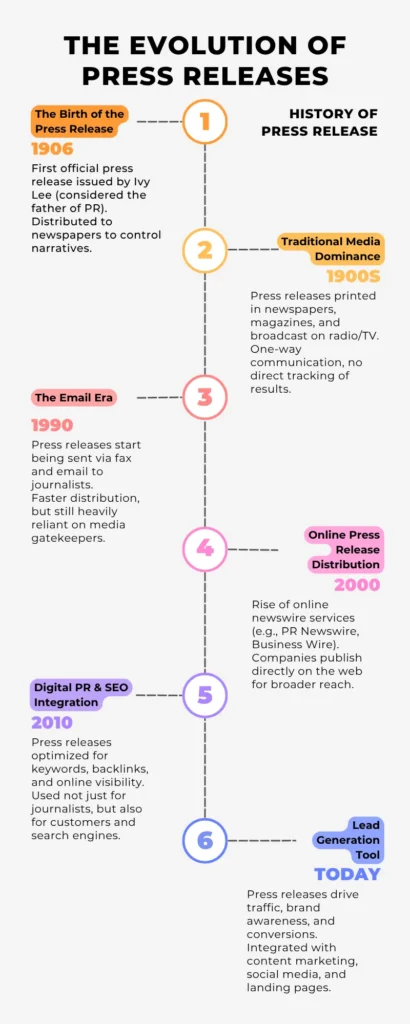
Step 1: Identify your audience (journalists, customers, or investors)
Before you start writing, you need to know who you’re writing for. A press release isn’t one-size-fits-all. The tone, angle, and even the call-to-action should shift depending on whether your goal is to reach journalists, potential customers, or investors.
Here’s how to break it down:
- Journalists: They want stories, not ads. Focus on what’s newsworthy—like a product launch, major partnership, or industry impact. Keep it clear, factual, and easy to report on.
- Customers: These readers care about benefits. Highlight how your announcement solves a problem, makes life easier, or adds value. Add links to offers, free trials, or landing pages to capture leads.
- Investors: They’re interested in growth potential. Showcase milestones, revenue growth, or market expansion. Numbers, forecasts, and achievements speak louder here.
👉 Pro tip: Create a reader persona for each audience type. For example, “Tech Journalist covering startups” or “Small business owner seeking marketing tools.” This keeps your messaging sharp and targeted.
When you know your audience, you can tailor the press release to resonate with them—making it far more effective at driving leads.
Step 2: Define Your Goal (Brand Awareness, Traffic, Event Promotion, Product Launch)
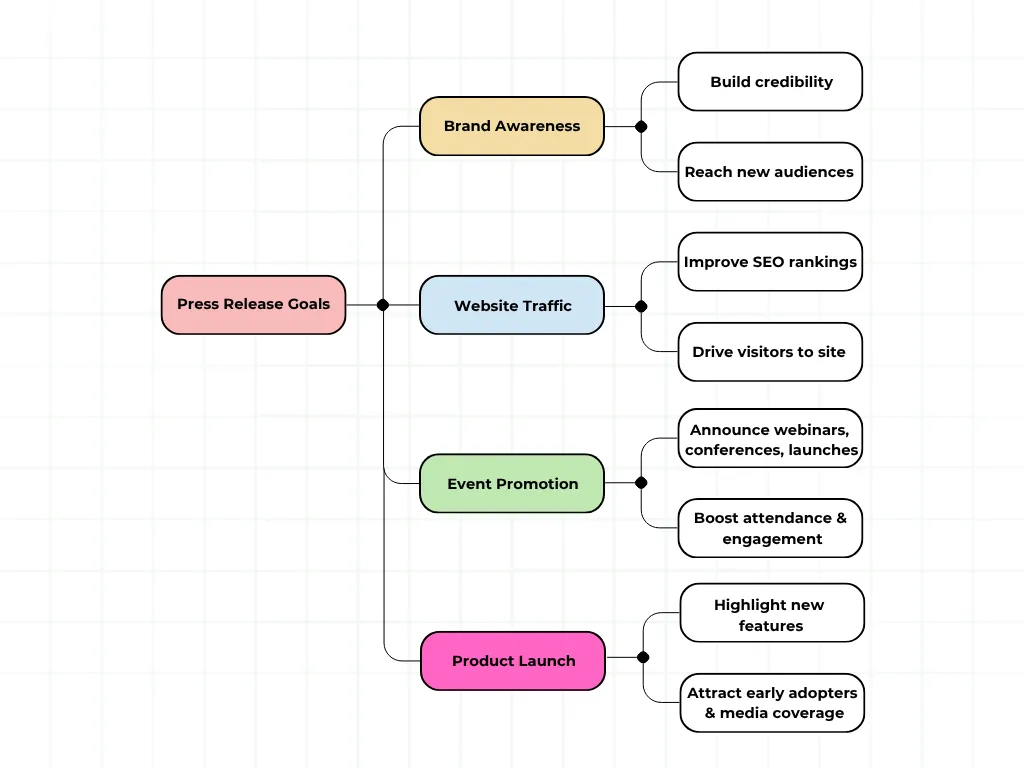
Every effective press release starts with a clear purpose. Without a defined goal, your message can feel scattered and fail to deliver results. Ask yourself: What do I want this press release to achieve?
Here are four common goals to guide your strategy:
- Brand Awareness: Perfect for introducing your company to new audiences or positioning yourself as an industry leader. Focus on storytelling and credibility.
- Website Traffic: If your goal is to drive clicks, include links to relevant landing pages, blog posts, or sign-up forms. Make sure they’re trackable with UTM parameters for accurate results.
- Event Promotion: Hosting a webinar, conference, or community event? Highlight the who, what, when, and where while creating urgency with limited seats or early-bird offers.
- Product Launch: For new product announcements, showcase unique features, customer benefits, and why it’s a game-changer. Add quotes from your team or early adopters for extra impact.
👉 Pro tip: Tie your press release goals directly to lead generation metrics (like email sign-ups, demo requests, or trial downloads). This ensures your efforts don’t just create buzz—they actually move potential customers closer to conversion.
Defining your goal upfront keeps your writing focused, your message aligned, and your results measurable.
Step 3: Craft a Strong Headline That Doubles as an SEO Keyword Opportunity
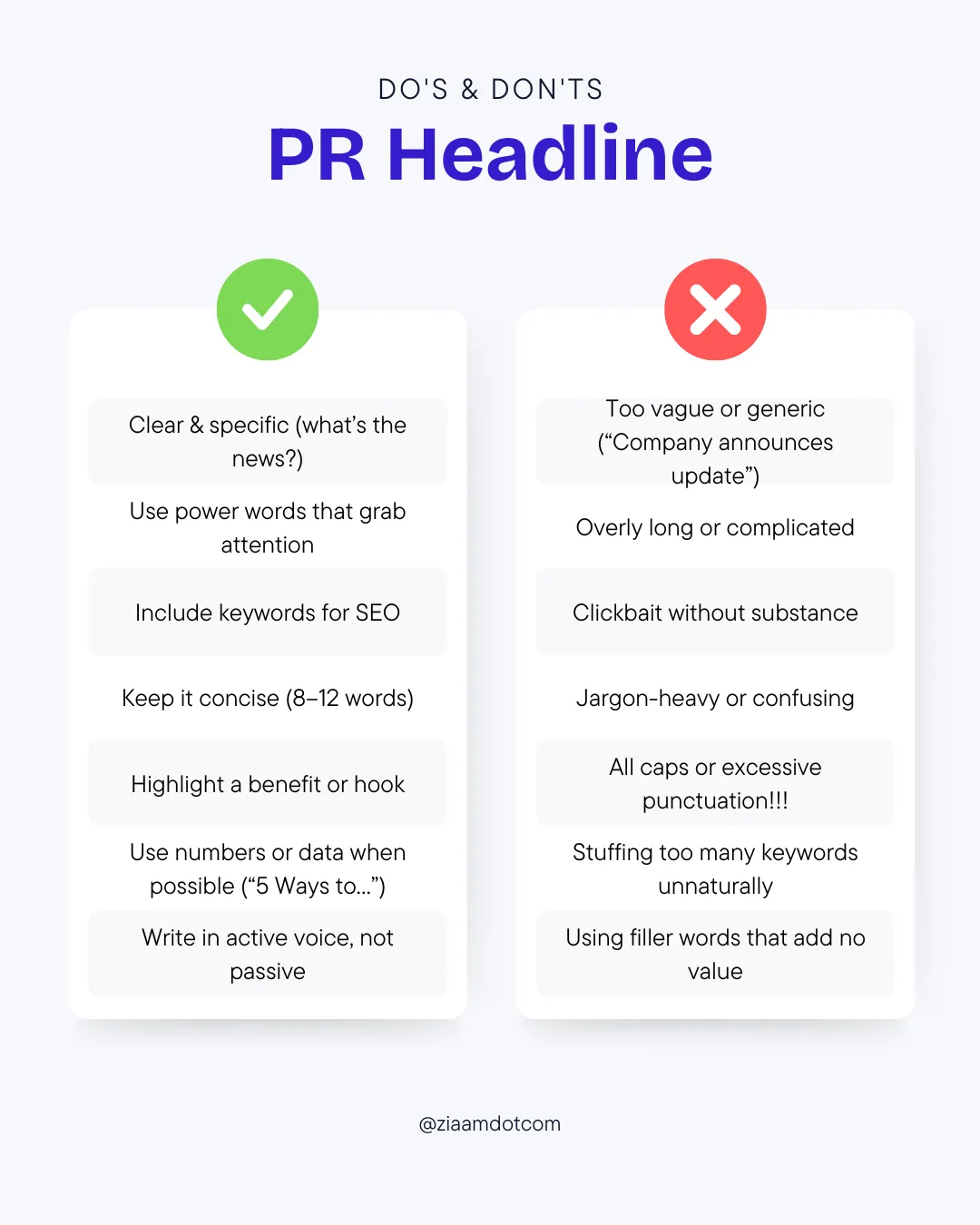
Your headline is the first thing journalists, customers, and search engines see—so it needs to work double duty. A strong press release headline should grab attention and improve your visibility in search results.
Here’s how to make it happen:
- Be Clear, Not Clever
Avoid vague phrases. Instead, write headlines that instantly tell readers what the news is about. For example:- Weak: “Exciting Update from Our Company”
- Strong: “XYZ Software Launches AI Tool to Help Small Businesses Save 40% on Marketing Costs”
- Incorporate SEO Keywords Naturally
Research what your audience is searching for using tools like Google Keyword Planner, SEMrush, or Ahrefs. Then weave those keywords into your headline without sounding forced. - Highlight the Value
Ask yourself: Why should anyone care? A great headline teases the benefit or impact of your announcement. - Keep It Short and Punchy
Aim for 6–12 words (under 70 characters) so your headline is easy to scan and fits well in search snippets.
👉 Pro tip: Write 3–5 headline variations, test them internally, and choose the one that’s both search-friendly and newsworthy.
A strong headline doesn’t just capture clicks—it ensures your press release gets found, read, and remembered.
Step 4: Write a Compelling First Paragraph with the 5 Ws
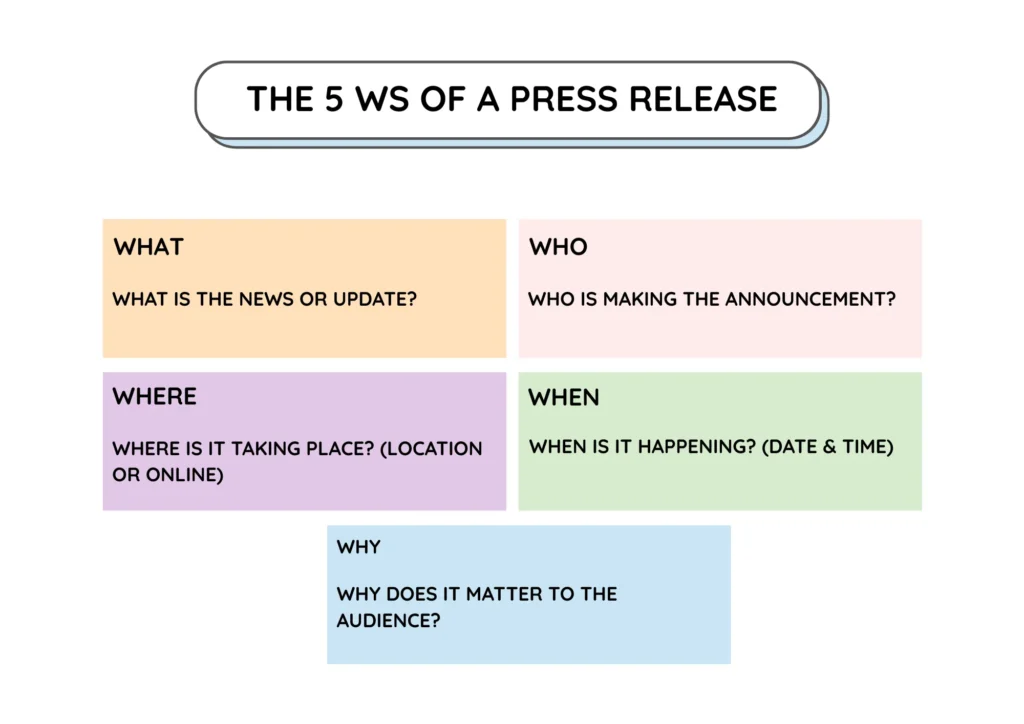
Once your headline grabs attention, your first paragraph needs to deliver the key details quickly. Journalists, readers, and even search engines scan the opening lines to decide if your press release is worth their time. That’s why you should always structure it around the classic 5 Ws:
- Who – Who is making the announcement? (Your company, brand, or spokesperson)
- What – What’s the news? (Product launch, event, award, new partnership, etc.)
- When – When is it happening? (Date, timeline, or immediate availability)
- Where – Where is this taking place? (Location or market focus)
- Why – Why does it matter? (The value or impact for customers, investors, or the industry)
💡 Example of a strong first paragraph:
“XYZ Software, a New York–based SaaS company, announced today the launch of its AI-powered marketing tool designed to help small businesses cut campaign costs by 40%. The product is available immediately to U.S. customers and aims to make advanced marketing automation more accessible to local businesses.”
Notice how in just a few lines, it answers who, what, when, where, and why—making it easy for journalists to quote and readers to stay engaged.
👉 Pro tip: Keep the first paragraph under 60–80 words. Think of it as your press release’s elevator pitch.
Step 5: Build the Story with Benefits and Insights (Not Fluff)
After you’ve set the foundation with your headline and opening paragraph, it’s time to expand the story in a meaningful way. This is where many press releases go wrong—by stuffing the content with generic phrases like “industry-leading solution” or “cutting-edge technology.” Instead, focus on benefits, insights, and real value.
Here’s how to do it right:
- Highlight the benefits – Explain how your announcement helps your target audience. Does it save time, cut costs, or solve a pressing challenge?
- Back it up with data – Use statistics, case studies, or survey results to add credibility. (For example: “Early testers reported a 35% increase in qualified leads within two weeks.”)
- Add expert insights – Include a short quote from a founder, manager, or industry expert to humanize the release.
- Connect to bigger trends – Show how your news ties into what’s happening in the market or industry.
💡 Think of this section as storytelling with proof. Instead of saying your product is “innovative,” demonstrate it with facts, numbers, and customer wins.
👉 Pro tip: Keep your sentences concise and avoid jargon. Journalists and readers should be able to instantly understand why your announcement matters.
Step 6: Insert Credibility Through Quotes (Executives, Clients, Partners)
A press release without quotes often feels flat. Adding quotes gives your story credibility, personality, and authority. Instead of simply reporting facts, you’re allowing readers to hear directly from the people behind the announcement—or those impacted by it.
Here’s how to use quotes effectively:
- Executive quotes – Share vision and leadership perspective. For example, a CEO might say how the launch ties into the company’s long-term goals.
- Client or user quotes – Demonstrate real-world impact. A happy customer sharing results can be more persuasive than any marketing statement.
- Partner quotes – If you’re collaborating with another company, their endorsement adds trust and strengthens your credibility.
💡 Pro tip: Keep quotes short, clear, and natural. Avoid jargon-heavy statements like “We’re leveraging synergies.” Instead, use authentic language that adds context or excitement.
By weaving in quotes, you humanize your press release and give journalists ready-to-use soundbites that make your story more shareable.
Step 7: Optimize for SEO (Keywords, Backlinks, Anchor Text)
A press release isn’t just for journalists—it’s also a powerful SEO asset. If done right, it can help your brand rank higher in search results and attract organic traffic that fuels lead generation.
Here’s how to do it:
- Use target keywords naturally – Sprinkle in relevant phrases (like your product, service, or location) without keyword stuffing.
- Include backlinks – Link back to your website, landing pages, or blog posts to drive readers directly into your funnel.
- Add optimized anchor text – Instead of linking “click here,” use descriptive text (e.g., “Download our lead generation guide”).
- Leverage multimedia – Images, videos, or infographics can also boost visibility in Google’s search results.
By optimizing for SEO, your press release works double duty: it tells your story and helps you capture organic leads long after publication.
Step 8: End with a CTA That Drives Readers to a Landing Page or Lead Magnet
Never let your press release end without telling readers what to do next. A clear call-to-action (CTA) is the bridge between generating buzz and actually capturing leads.
Here are some effective ways to do it:
- Direct to a landing page – Link to a page where readers can learn more, sign up, or take the next step.
- Offer a lead magnet – Think free eBooks, reports, checklists, or webinars that align with your story.
- Encourage subscriptions – Invite readers to join your email list or newsletter for ongoing updates.
- Highlight urgency – Use phrasing like “limited seats available” or “download before the offer expires” to drive action.
A strong CTA makes your press release more than just news—it becomes a lead generation engine.
Conclusion: Press Releases That Don’t Just Inform—They Convert
A well-crafted press release is no longer just a PR tool—it’s a strategic lead generation asset. By identifying your audience, setting clear goals, writing with SEO in mind, and ending with a powerful CTA, you turn a simple announcement into a business growth opportunity.
The key is to focus on value. Journalists want a story, customers want solutions, and investors want proof of credibility. If your press release delivers on all three, you’ll not only capture attention but also drive meaningful leads into your funnel.
So the next time you sit down to draft a release, don’t just ask, “How do I share this news?” Instead, ask, “How do I turn this news into leads?”
👉 Need help writing SEO-friendly press releases that actually generate leads? Let’s connect—I specialize in crafting content that grows visibility and converts.
Recommended Articles
-
How Google Search Results Sorted Frequency Affects You in 2025
8 months ago119 views -
21 Creative Content Ideas for Cake Businesses
2 years ago366 views -
How to Register Business for Voice Search – Ultimate Guide
1 year ago336 views -
ChatGPT vs Claude: A 2025 Comparison of AI Models
4 months ago183 views -
20 Best Freelancing Platforms to Find Work in 2025
6 months ago284 views -
Why Every Local Business Needs a Digital Marketing Strategist in 2025
3 months ago90 views
Leave a Reply
You must be logged in to post a comment.



